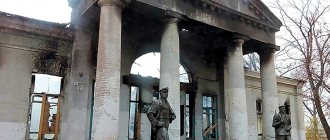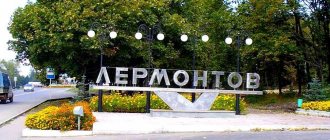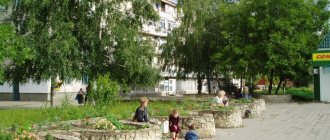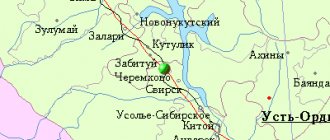City in Rostov region, Russia
| Mines Mines | |
| City[1] | |
| View of the city from the KhBK side. | |
| Flag Coat of arms | |
| Location of the Mine | |
| Mines Location of the Mine Show map of Russia Mines Mines (Rostov region) Show map of Rostov region | |
| Coordinates: 47°42′N 40°14'E / 47.700°N Latitude 40.233°E / 47.700; 40.233Coordinates: 47°42′N 40°14'E / 47.700°N Latitude 40.233°E / 47.700; 40.233 | |
| A country | Russia |
| Federal subject | Rostov region[1] |
| Based | early 19th century[2] |
| Government | |
| • Mayor | Denis Stanislavov[3] |
| Height | 100 m (300 ft) |
| population (2010 Census)[4] | |
| • General | 239,987 |
| • Evaluate (2018)[5] | 233,814 (−2.6%) |
| • Classify | 79th in 2010 |
| Administrative status | |
| • Subordinate | Mines City District[1] |
| • Capital from | Shakhty urban district[1] |
| Municipal status | |
| • Urban district | Shakhty urban district[6] |
| • Capital from | Shakhty urban district[6] |
| Timezone | UTC + 3 (MSK [7]) |
| Postal code(s)[8] | 346500 |
| Dial code(s) | +7 8636 |
| OKTMO I WOULD | 60740000001 |
| Day of the city | Third Sunday in September |
| Web site | www.shakhty-gorod.RU |
Mines
(Russian: Shakhty, IPA: [ˈꟅaxtɨ]) is a city in Rostov region, Russia, located on the southeastern spur of the Donetsk Range, 75 km northeast of Rostov-on-Don. As of the 2010 Census, its population was 239,987.[4]
Previously it was known as Alexandro-Grushevskaya
(until 1867),[2]
Mountain Grushevskoye Settlement
(until 1881),[2]
Aleksandrovsk-Grushevsky
(until 1920).[2]
Story
At the beginning of the 19th century[2] Sergeant Major Popov founded[ citation needed
] on R. Grushevka and Cossack
village
from
Aleksandro-Grushevskaya
(Alexandro-Grushevskaya).[2]
Although the exact reason for this name is unclear, it is possible that the name was given in honor of the Emperor. Alexander I.[2] Twelve Cossacks and fourteen peasant serfs lived in the village
at this time.[
citation needed
] By the mid-19th century, there were 57 coal mines operating in the area.[2]
In 1867 it received city status and was renamed. Gornoye Grushevskoye Settlement
(Gornoe Grushevskoye Settlement).[2]
The name was changed to Aleksandrovsk-Grushevsky
(Alexandrovsk-Grushevsky) in 1881.[2]
By 1914 the population had reached 54,000. The main source of income was coal mining, which had been carried out in this region since the late 18th century. The population was poor, but the city had a railroad, telegraph and telephone network, electricity and running water, as well as libraries, hospitals and a post office. In 1917, the city changed hands three times until it was captured on April 28, 1919 by the Don Army, under General Fitzkhelaurov. For twenty months he was independent of the Bolsheviks, but was ravaged by typhoid fever.
In 1920, the city was given its current name.[2] A name that literally means mines
in Russian was chosen due to its close connection with coal mining.[2] In 1920–24, Shakhty was part of the Donetsk Governorate of the Ukrainian SSR. During the 1920s, many churches and archives were destroyed. In 1928, the city hosted the Shakhty Trial, a predecessor to the show trials of the 1930s.
In 1941, an independent Cossack republic was proclaimed in Shakhty, although this was suppressed by the NKVD before the Russian invasion.[9] In July 1942, during the Great Patriotic War, the city was occupied by the Germans; many coal pits and buildings were blown up by the Germans during their retreat in February 1943. Twenty-nine city residents were awarded the title Hero of the Soviet Union.
In 1948, production at the mines reached pre-war levels. During Leonid Brezhnev's years, the city was at the peak of its development, its population exceeded 250,000 people, and about ten million tons of coal were mined annually.
In the 1970s and 1980s, the city was the scene of many Andrei Chikati murders.
The redevelopment proved devastating for the city, as the mines were privatized and closed, causing mass unemployment, which led to a serious increase in crime and drug abuse. Today's Shakhty is the main industrial center of Eastern Donbass. The city is also one of the main producers and exporters of tiles in Eastern Europe.
Mines during the Soviet period
From the end of the twenties, already in the USSR, the laying of new mines continued, and in order to train management personnel for coal mining enterprises in the city, the Shakhtinsky Mining College was opened in 1931. In 1933, all the city mines were united into a single structure - the Shakhtantracite trust. And in 1938, he joined the even larger Rostovugol association, which, in addition to the Shakhty trust, also included Gukovugol and Nesvetayanthracite. And the leadership of this entire association was located in Shakhty.
Coal mining here practically ceased during the Great Patriotic War, especially during the occupation period. But already in 1945, in spite of everything, the coal mining enterprises of the Shakhty started working again and produced the first coal.
In 1990, there were eight mines operating in the city. By 1995, the difficult economic situation in the country led to the closure of five of them.
Attractions
There are many monuments and museums in Shakhty.
Drama Theater Monument to Vasily Alekseev
- Monument to Alexander II. The monument to Emperor Alexander II was unveiled on April 29, 2015. It is installed in front of the main building of the Institute of Service and Entrepreneurship of the Don State Technological Institute (DSTU) in the city of Shakhty. The monument was built using voluntary donations. The right to conduct its opening was granted to the representative of the House of Romanov, the great-grandson of Emperor Alexander III, Pavel Eduardovich Kulikovsky-Romanov.
The pedestal is made of dark granite, and the statue of Alexander II is cast in bronze. The height of the monument is 5.7 meters, and the figure of Alexander II is 2.4 meters.
On the front side there is the inscription “Alexander II” in gold letters. Tsar Liberator." On the reverse side there is a brief biographical information about the ruler: “Emperor Alexander II. abolished serfdom in Russia in 1861 and freed millions of peasants from centuries of slavery, carried out military and judicial reforms, introduced a system of local government, city councils and local administrations, put an end to the long-term Caucasian War, and freed the Slavic peoples from the Ottoman yoke. He was killed on March 1, 1881, the victim of a terrorist.[12][13]
Fountain in the park (1920-1930)
The monument was erected on the initiative of the Historical Council of the city of Shakhty. Sculptor - Yuri Alekseevich Levochkin.[14]
- Monument to Vasily Alekseev (2014). Vasily Ivanovich Alekseev was a Soviet weightlifter.[15][16] He set 80 world records and 81 Soviet records in weightlifting, and won gold medals at the 1972 and 1976 Summer Olympics.[17] Alekseev was born in the city of Shakhty.
- Monument to the Soldier-Liberator (1985)
- Memorial to the victims of fascism (1975)
- Monument to fighters for Soviet power (1955)
- Monument to Internationalist Soldiers (2010)
- Monument to Taras Shevchenko (1972)
- Monuments to Lenin (1945). Vladimir Ilyich Ulyanov was a Russian communist revolutionary, politician and political theorist.
- Memorial to the heroes of the First World War (2014). The monument depicts a double-headed eagle. In the paws is a cadet standard, with the monogram of the Russian Emperor Nicholas II. The names of all the Don Cossack detachments that participated in the First World War are engraved on the plates under the eagle’s wings.
“This is a dying city!” — a famous Moscow journalist criticized Shakhty
Recently, Mines began to be often mentioned in various ratings and discussions of well-known YouTube and TV channels. By scoring social and political points, bloggers and politicians directly influence the image of the Mines, often causing despondency and disagreement among the residents themselves.
One of the recent “star” guests of the city was the famous journalist, and now politician - deputy of the legislative assembly of the Vladimir region Maxim Leonardovich Shevchenko. As announced in “KVU” No. 3 dated January 19, 2022, he held a meeting with Shakhty residents in the palace of culture of the village of KhBK.
Talking about what he saw in our city, Maxim Leonardovich emphasized that he sees “such a picture” in all cities of Russia, excluding only “two capitals.” And he saw what they showed him: city construction sites and slums. They told him about the rest (the glorious Soviet past). Bright, colorful, as they usually describe their youth.
But what can you learn about the city today in two or even 10 hours of stay? Many have lived here since birth, and not everyone, and not always, know about what is being done, how it is being done and by whom (which is also very important), and what else is planned.
Of course, we have many problems, many obvious places that are easily put into the head by the bright word “Guard!”
And so it happened. A few days later, an interview appeared on Andrei Karaulov’s YouTube channel, in which Maxim Shevchenko told the whole world (the channel’s audience):
“The mines are a dying city. This is a city of two hundred thousand, which was prosperous during Soviet times. There were nine working mines there. “The city is a billionaire,” as the residents themselves said. The supply there was, as they said in Soviet times, “at Moscow level.” Everything was there: schools, educational institutions... People came there specifically to live there, from all over the country.
All mines are closed. They took me around and showed me huge crumbling blocks. They are building new houses, but there are no communications; they have not been able to open a school for three years.
There (in the city, before) it was like this: men worked in the mines, women worked in a huge cotton processing plant, everyone lived very well. …Now it’s a gradually dying space.”
Someone will agree with his words, but let's speak frankly, “the devil is not as terrible as he is painted.” And our city is not painted very beautifully today. Yes, this is partly true reality, but then what? Are we going to do something or are we just talking, getting angry and then standing around waiting for our bus?
What to do
Shevchenko, at a meeting with Shakhty residents, recalled a special tool to which officials respond faster than written appeals. This is the Internet.
I filmed a rush of water, a collapsing wall, a pack of wild dogs, a broken road on my mobile phone... posted it on social networks, sent the video to a famous blogger - consider half the job done.
- They will definitely react! Officials are wildly afraid of publicity,” Shevchenko emphasized.
Instead of an afterword...
This is what KVU constantly talks about, which is why they turn to us for help in the last hope of changing something. This is often possible. After all, if you stay on the sidelines, then soon there will be no place left there either.
It is caring readers who help transform our city without excuses and replies that delay the resolution of pressing issues.
Maxim Leonardovich thanked the editors of KVU for covering urban problems, and left an autograph as a souvenir of his visit to the Mines.
Recommendations
Notes
- ^ a b c d f
Law No. 340-ZS - ^ a b c d f g gram hour i j k l
Pospelov, p. 26 - Official website of the Shakhty city administration. Denis Ivanovich Stanislavov Archived March 11, 2014 Wayback Machine (in Russian)
- ^ a b c
Federal State Statistics Service of Russia (2011).
“All-Russian Population Census 2010. Volume 1" [All-Russian Population Census 2010, vol. 1]. All-Russian Population Census 2010 [All-Russian Population Census 2010]
(in Russian). Federal State Statistics Service. - "26. The size of the permanent population of the Russian Federation by municipalities as of January 1, 2022.” Federal State Statistics Service. Retrieved January 23, 2022.
- ^ a b c
Law No. 191-ZS - "On the calculation of time." Official Internet portal of legal information
(in Russian). June 3, 2011. Retrieved January 19, 2022. - Post office. Information and computing center of OASU RPO. ( Post office
).
Search for postal facilities ( Search for postal facilities
) (in Russian) - p.88, Stalingrad, Anthony Beevor
- Federal State Statistics Service of Russia (May 21, 2004). “The population of Russia, the constituent entities of the Russian Federation as part of federal districts, urban settlements, urban settlements, settlements, settlements of 3 thousand or more people.” [Population of Russia, its federal districts, federal subjects, districts, urban settlements, rural settlements - administrative centers, rural settlements with a population of more than 3000 people] (XLS). All-Russian Population Census of 2002 [All-Russian Population Census of 2002]
(in Russian). - “All-Union Population Census of 1989. The actual population of the union and autonomous republics, autonomous regions and districts, territories, regions, urban settlements and villages. Members of the IOPS took part in the opening of the monument to Emperor Alexander II in Shakhty.” ippo.ru.
_ Retrieved October 7, 2022. - “A monument to Alexander II was opened in the city of Shakhty - Administration of the city of Shakhty.” shakhty-gorod.ru
. Retrieved October 7, 2022. - “They began to erect a monument to Alexander II in Shakhty.” kvu.su
(in Russian). Retrieved October 7, 2022. - Fedorov, Gennady (November 25, 2011). “World record holder in weightlifting Alekseev died at the age of 69.” Reuters. Retrieved November 25, 2011.
- Croft, Lee B. (2002) [1992]. Dawson, Don P. (ed.). Great athletes
.
1
(Revised ed.). Salem Press. pp. 35–37. ISBN 1-58765-008-8. - Vasily Alekseev Archived June 22, 2016 Wayback Machine. sports-reference.com
- "Twin Cities". shakhty-gorod.ru
(in Russian). Mines. Retrieved February 4, 2022.
Sources
- Legislative Assembly of the Rostov region. Law No. 340-ZS of July 25, 2005 “On the administrative-territorial structure of the Rostov region,” as amended. Law No. 270-ZS of November 27, 2014 “On Amendments to the Regional Law” On the Administrative-Territorial Structure of the Rostov Region “”. Came into force on the date of official publication. Published: “Our Time”, No. 187–190, July 28, 2005 (Legislative Assembly of the Rostov Region. Law No. 340-ZS of July 28, 2005 On the administrative-territorial structure of the Rostov Region
As amended by the Law of November 27, 2014 No. 270 -ZS.
On amendments to the regional law "On the administrative-territorial structure of the Rostov region"
. Valid from the date of official publication.). - Legislative Assembly of the Rostov region. Law No. 191-ZS of November 19, 2004 “On establishing the border and granting the status of an urban district to the municipal formation” City of Shakhty,” as amended. Law No. 627-ZS of January 12, 2007 “On amendments to some regional laws on establishing the boundaries of municipalities and giving them the proper status.” Came into force on the date of official publication. Published: “Our Time”, No. 285–286, November 23, 2004 (Legislative Assembly of the Rostov Region. Law No. 191-ZS of November 19, 2004 On establishing the border and assigning the status of an urban district to the municipal formation “city of Shakhty”
As amended Law of January 12, 2007 No. 627-ZS.
On amendments to various regional laws on establishing the boundaries of municipalities and granting them the appropriate status
. Valid from the date of official publication.). - E. M. Pospelov (E. M. Pospelov). “Names of cities: yesterday and today (1917–1992). Toponymic Dictionary". ( Names of cities: yesterday and today (1917–1992). Toponymic dictionary.
) Moscow, “Russian Dictionaries”, 1993.
Where is the city of Shakhty?
Shakhty is a city in the southwestern part of the Rostov region, which is located on three rivers: Ayuta, Grushevka and Kadamovka.
It is located 26 km from the border with Ukraine on the south-eastern slopes of the Donetsk Ridge. It has the status of a supporting center of the East Donbass agglomeration. The approximate population of the city is 235 thousand people, the area of the city is 158 square kilometers. There are more than 20 reservoirs on the territory of the city of Shakhty. The largest body of water is the Artemovskoye Reservoir, which is more than 2 km long. The climate in the city is temperate continental, with characteristic features of the subtropical Mediterranean. The annual precipitation rate is about 400 mm.
The mines are located in the same time zone as Moscow, the offset relative to Coordinated Universal Time (UTC) is +3.
Map of Shakhty with houses
About 230 thousand people live in the city, slightly less than half work in local plants and factories. Residential buildings in the settlement do not exceed 5 floors. Significant areas are built up by the private sector, and apartment buildings are traditional Khrushchev buildings of the Soviet period. The location of any building can be found on the Mine map with house numbers.
The city also preserved buildings from the beginning of the last century, but their condition cannot be called satisfactory. Generations of city residents were brought up in the spirit of the “Soviet miner” and were accustomed to working, rather than creating history and building architectural monuments.
And yet, within the city there are several places worthy of attention by local residents and guests of Shakhty. For example, the Cathedral of the Intercession of the Blessed Virgin Mary, which is shown on a detailed map of Shakhta. This is a blue and white temple with golden domes. During Soviet times, it was dilapidated and was able to open its doors after restoration only in the late 90s.
It is also interesting to visit the local museum, the exhibitions of which are related to the opening of coal mines and the development of coal industry enterprises.
Map of Shakhty with streets
The map of Shakhty by district shows that the railway track of the North Caucasus Railway runs through the western part of the city. On the Liski-Millerovo stretch there is a small station Shakhtnaya. The city has a small bus station with a platform that provides bus service to neighboring cities. On the map of the mine with streets it can be found on Victory of the Revolution Avenue.
European and Russian highways also pass through the city. The M-4 Don highway covers the Ayutinsky and International villages.
On one of the central streets - Vasily Alekseev Avenue, there is the main recreation area for the townspeople - Alexander Park, and not far from it a modern Ice Palace was built.
The main main streets of Shakhty are:
- Soviet;
- Mayakovsky;
- Ionova;
- Novocherkasskaya;
- Vasily Alekseev Avenue;
- Karl Marx Avenue.
They are located on large shopping centers, banks, restaurants, which are marked on the map of the mine with streets and houses. Also in the central part of the city you can see such objects as:
- Preschool and general education institutions;
- University and colleges;
- Sport complexes;
- Central layout for performances;
- Hospitals;
- MARRIAGE REGISTRY.
For those who visited this mining town for the first time, it is better to use the map of Mine with houses so as not to get lost at the intersection of numerous streets, alleys and driveways. Armed with such an “online assistant”, you can take a walk along the local “Arbat” - the pedestrian Shevchenko Street.








